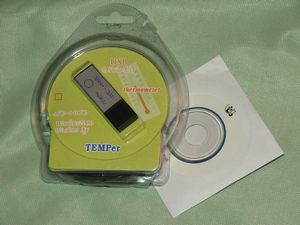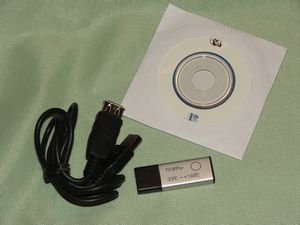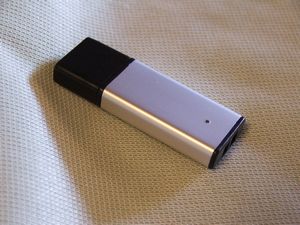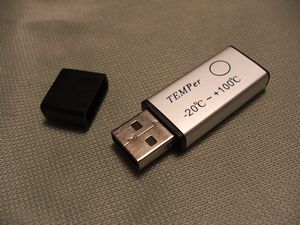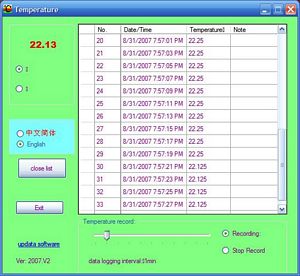I’ve been doing reviews for quite some time now and I’ve come to learn you can never have enough testing equipment. USBFever has sent me something that I think most other reviewers out there and the general populace might be interested in. It’s called the TEMPer, and it’s a USB thermometer that was actually made specifically for laboratory use so it is made to be accurate and easy to use. It’s essentially made to test the ambient air temperature in the room and can be plugged into a USB port or used with the included USB extension cable. Software is even included that allows you to record temperatures at user designated intervals. Overall it’s a great gadget that I’ll be adding to my list of standard testing equipment.
Review: TEMPer USB Thermometer from USBFever
Reviewed by: Kristofer Brozio AkA Dracos
Sponsor: USBFever
Tech Specs,Features or the Basic Info:
Product Code#:E176-B102
Features:
– Powered by USB
– Temperature Range: -20° C ~ 100° C (or -4° F ~ 212° F)
– Data is to be log from every 1 min to every 12 hours/once
– Data could be copy-and-paste to Word or Excel
– USB Interface
Recommends for:
– Laboratory
Package Contents:
– TEMPer (USB Thermometer) x 1
– USB Cable x 1
– Driver CD x 1
Note:
Data in the spread sheet could only be in Celsius
Price: US$19.99
A Better Look at Things
:
The TEMPer comes in a small plastic clamshell that is the easy open type, you can plainly see the small USB Thermometer through the front of the package, it’s smaller than the average USB flash drive. A mini-cd comes with it that includes the graphic interface and drivers.
On the back of the package we can see some writing in Japanese or Chinese, the words Hygro-Thermometer and we can see the USB extension cable as well. The words Hygro-Thermometer are a bit misleading as a ‘hygro’ type of thermometer is used for not only temperatures but to measure the humidity as well, this device does not measure humidity as far as I can tell.
Here’s everything opened up for a better look:
The top of the TEMPer has the name, a small circle for whatever reason and the temperature range. The back end also has a slot that can be used to attach a lanyard if need be.
The bottom of the TEMPer is plain with the exception of a tiny hole that I would have to guess is the temperature sensor itself.
The main body of the TEMPer is made of metal with the ends and cap being made of plastic, so it appears to be a very durable little device.
Installation, Testing and Comparison
Installation is fairly simple for the most part as there are no included instructions of any kind. On the disc are a couple folders, including programs to update and/or install .NET Framework which is required to run the software.
There is a driver program that will install the actual drivers for the TEMPer, which is written in another language, but the prompts are easy to follow.
The actual software installation is in the same language, but here again just keep clicking the highlighted button and it will install.
Once installed a small icon appears on your desktop to start the monitoring program. There’s really not much to it, you can change the language to English which is a welcome choice, and you can choose between Fahrenheit and Celsius.
One thing I did run across when starting the program was an Unhandled exception error in .NET Framework but clicking continue fixed it fine and the program worked. Although every time I started the program it gave me that error, not a big deal really…
There is a button labeled ‘TEMP List’, clicking this opens the full panel you see in the above picture (turns to ‘close list’ when opened) and it also offers the choices to start recording and stop recording. You can also choose the time intervals at which to record the temperatures, the intervals being one second, one minute, 30 minutes and 12 hours. The temperatures are recorded to three decimal places for accurate measurements.
To compare the ambient room temperature to the TEMPer I used my trusty Radio Shack digital thermometer and the thermometer I have built into the thermostat for the heating/cooling of my house in the same room.
The temperatures seemed very close in comparison for all three devices. While the thermostat does not give me any decimal places the Radio Shack one does go to one decimal place. When comparing them I found them to all be close in temperatures of my room.
An example would be that my thermostat showed 29C, while the Radio Shack thermometer showed 29.2 and the TEMPer showed 29.875C.
It’s not in my budget to afford a high quality laboratory grade thermometer, these do give a good idea of the ambient temperature and I think the TEMPer should be the correct one as it is made for use in a laboratory.
Summary:
Overall I found the TEMPer USB Thermometer to be a great device, with the slight exception of the software. Even so, the software is useable, and I found it quite capable to do what it needs to do.
The rep from USBFever did mention to me that the software wasn’t quite perfect, and that this device was intended for laboratory usage so it is supposed to be very accurate in regards to ambient air temperatures. The main reason I wanted to review this item was based on the idea that it was made for a laboratory and made to record accurate temperatures.
The TEMPer does what it is supposed to do, seems to be very accurate, and is easy to use.
DragonSteelMods gives the TEMPer USB Thermometer a 4.5 out of 5 score.

Pros:
-Works great
-Easy to install
-Data logging capabilities
-Seems to be accurate
-Small and portable
Cons:
-Software is not quite perfect yet…
-No instructions
I would like to thank USBFever for the chance to review the TEMPer USB Thermometer and for their continued support of DSM.
review# 280


